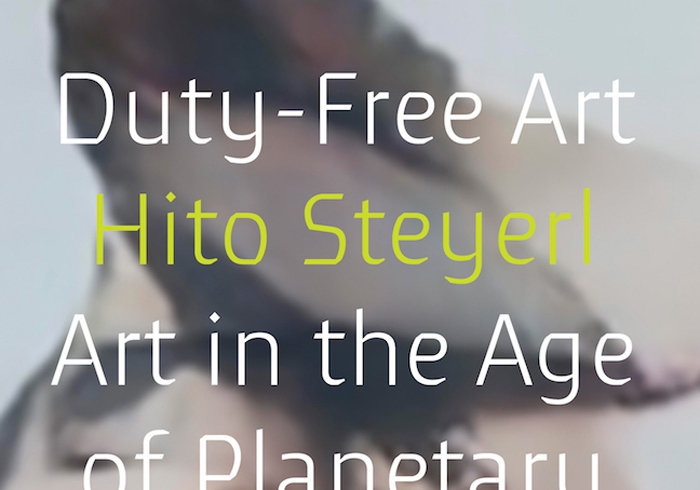Being Hito Steyerl must be intense. On the evidence of the entertaining, often thoughtful, breathlessly inconclusive, yet voguishly insistent public talks and short essays that comprise Duty Free Art: Art in the Age of Planetary Civil War, the artist sees reality as a global hell of indefinite civil wars, ‘deep state’ surveillance, delusional populations churned through social media, financialised capitalism floating improbably on seas of debt and thousands slaughtered by algorithmically guided missiles while artificial intelligence seeps relentlessly into the catastrophic postdemocratic consciousness of a networked society that hasn’t yet realised the net isn’t the utopia we were looking for. And somewhere in all of this is the artworld: broken, corrupt, complicit, idiotic, with perhaps just a hint of agency and value to be rescued from the surrounding wreckage.
If all this sounds familiar, that’s simply a measure of how Steyerl’s hyperactive, wired-in attention to the critical currencies of art and politics, post-Internet, has influenced the artworld’s awareness of these themes over the last decade. Duty Free Art isn’t the Steyerl of austere, melancholic early films such as November (2004) or Lovely Andrea (2007), but the artist’s response to the postcrash world, where economic crisis merges with Web 2.0 hegemony and contemporary art turns out to be neoliberalism’s court jester.
Steyerl is at her most original when gleefully hacking away at those old binary, philosophical, aesthetic and political distinctions between images and everything else, between subjects and objects, between representations and what they represent: ‘reality now widely consists of images; or rather, of things, constellations, and processes formerly evident as images’, she writes in ‘Is the Internet Dead?’, while ‘humans and things intermingle in ever-newer constellations to become bots or cyborgs’. And the image is no longer an object to be beheld by an active human subject; discussing the weird image-dream of one of Google’s AI machine-learning experiments, Steyerl sees in it not comic weirdness but the ‘ubiquitous surveillance of networked image production, a form of memetically modified intelligence that watches you’. Images aren’t representations of reality, but the products of digital systems actively responding to humans: ‘As humans feed affect, thought and sociality into algorithms, algorithms feed back into what used to be called subjectivity,’ she writes in ‘Proxy Politics’.
Steyerl’s greatest trouble is her unwitting denigration of selfhood: supposedly we’re helpless against the system
For some of us, though, it’s still called subjectivity, and it becomes apparent that Steyerl’s greatest trouble is her unwitting denigration of selfhood: supposedly we’re helpless against the system. Servitude is a recurring trope: while the creative sector’s always-on ‘economy of presence’ demands that ‘the encounter with the artist [be] more important than the one with the work’, while the rest of us are forced to make ends meet in ‘dysfunctional, collapsing just-in-time economies’.
That acceptance of the human passivity in the face of technology and capital means that Steyerl’s proposed alternatives are often lukewarm and hesitant – deploying a Bartlebyesque form of absenteeism as a response to the ‘economy of presence’, or making a very conventional demand for more regulations on the art trade. No wonder. Behind her manic engagement with the rabbit holes of contemporary technopolitical paranoia that so fixate the liberal-left is an abject lack of a bigger idea of what the future could be, or any confidence that humans would even be capable of making it happen. But human agency in making history is passé: riffing on Walter Benjamin’s famous 1940 text on the ‘Angel of History’, who looks helplessly back on the ‘unceasing catastrophe’ of history piling events like ‘rubble on top of rubble’, Steyerl decides that ‘we, the spectators, might be the rubble’.
Underpinning this is a very prosaic confusion about contemporary capitalism, and the nature of liquidity’s relationship to the art economy. Steyerl vividly pictures the frantic financialisation of art through art fairs, global megamuseums and freeport art storage. Yet the sea of liquid value that art has come to embody isn’t accelerated ‘turbocapitalism’, as she seems to think, but its opposite: a stagnant, torpid system incapable of generating future prosperity, with art objects and institutions as the desperate store of fictitious capital that has nowhere to go. Steyerl definitely has her finger on the pulse of what artists like her already think. But Duty Free Art starts to reveal the limits of dwelling in this particular echo chamber.
